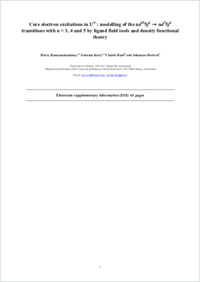Core electron excitations in U⁴⁺: modelling of the nd¹⁰5f² → nd⁹5f³ transitions with n = 3, 4 and 5 by ligand field tools and density functional theory
- Ramanantoanina, Harry Paul Scherrer Institute, Villigen PSI, Switzerland
- Kuri, Goutam Paul Scherrer Institute, Villigen PSI, Switzerland
- Daul, Claude Department of Chemistry of the University of Fribourg, Switzerland
- Bertsch, Johannes Paul Scherrer Institute, Villigen PSI, Switzerland
-
13.07.2016
Published in:
- Physical Chemistry Chemical Physics. - 2016, vol. 18, no. 28, p. 19020–19031
English
Ligand field density functional theory (LFDFT) calculations have been used to model the uranium M4,5, N4,5 and O4,5-edge X-ray absorption near edge structure (XANES) in UO₂, characterized by the promotion of one electron from the core and the semi-core 3d, 4d and 5d orbitals of U⁴⁺ to the valence 5f. The model describes the procedure to resolve non-empirically the multiplet energy levels originating from the two-open-shell system with d and f electrons and to calculate the oscillator strengths corresponding to the dipole allowed d¹⁰f² → d⁹f³ transitions appropriate to represent the d electron excitation process. In the first step, the energy and UO₂ unit-cell volume corresponding to the minimum structures are determined using the Hubbard model (DFT+U) approach. The model of the optical properties due to the uranium nd¹⁰5f² → nd⁹5f³ transitions, with n = 3, 4 and 5, has been tackled by means of electronic structure calculations based on the ligand field concept emulating the Slater–Condon integrals, the spin–orbit coupling constants and the parameters of the ligand field potential needed by the ligand field Hamiltonian from Density Functional Theory. A deep-rooted theoretical procedure using the LFDFT approach has been established for actinide-bearing systems that can be valuable to compute targeted results, such as spectroscopic details at the electronic scale. As a case study, uranium dioxide has been considered because it is a nuclear fuel material, and both atomic and electronic structure calculations are indispensable for a deeper understanding of irradiation driven microstructural changes occurring in this material.
- Faculty
- Faculté des sciences et de médecine
- Department
- Département de Chimie
- Language
-
- English
- Classification
- Chemistry
- License
- License undefined
- Identifiers
-
- RERO DOC 277371
- DOI 10.1039/C6CP01395C
- Persistent URL
- https://folia.unifr.ch/unifr/documents/304982
Other files
Statistics
Document views: 59
File downloads:
- dau_cee.pdf: 190
- dau_cee_sm.pdf: 89

